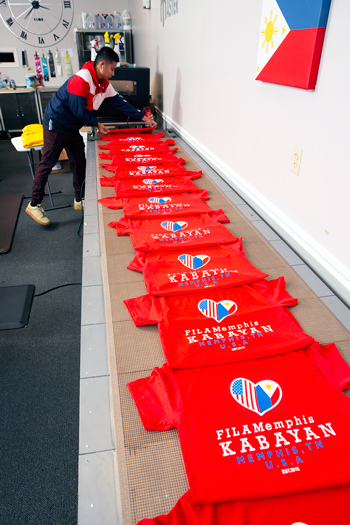MEMPHIS, TN — For 20 years, Edwin Lamanilao has owned and operated Memphis SportsMaster, a sports apparel store specializing in basketball uniforms. His love of the sport first sparked the idea of creating custom jerseys as a way to reinforce camaraderie and team spirit. Today, his apparel line has expanded to include full sublimation football and baseball uniforms as well as DTG printing of T-shirts and hoodies.
"Ninety percent of my business is basketball uniforms for schools," says Lamanilao, who outsources the fabrication of his uniforms to the Philippines. "I also have a contract with Shelby County (TN) School District to supply all sports uniforms."
Some of Lamanilao's customers started asking if he could supply T-shirts for parents and players as well. He had never printed garments in-house before, so he began watching YouTube videos and attending trade shows to learn about the digital printing process. In 2017, he purchased his first direct-to-garment (DTG) printer.
"I like the fact that I can print on demand, and there are no minimums," he says. "If a customer brings me one shirt, I can print just one shirt-and I can do it the same day while he or she waits."
Infrared dryer preserves vibrancy
As the demand for shirts increased, Lamanilao invested in a second DTG printer and moved the operation from his garage to a small retail store. Despite the influx of orders, some of his customers began complaining about the T-shirts' dull colors.
"I was drying the shirts with a heat press, but it reduced the vibrancy of the colors," he explains. "Operating the heat press was also labor-intensive and slow."
Lamanilao researched alternative curing options online and came across social media discussions about the benefits of using a conveyor dryer to cure DTG prints. After purchasing a third DTG printer, he bought a Vastex LittleRed® X3D infrared conveyor dryer developed specifically for DTG-printed garments.
The dryer is equipped with a 30 in. (76 cm) wide conveyor belt with three 24 in. (61 cm) wide infrared heaters that are height adjustable, allowing Lamanilao to position images at a consistent distance from the heaters whether printed on T-shirts, sweatpants or hoodies.
After discovering the unit's best heat control at 780°F (416°C) [boost] and 620°F (332°C) [main] belt control to 38 volts on white and 23 volts on colored shirts (about twice that of the heat press), Lamanilao places the printed shirts on the conveyor belt and adjusts the belt's speed as needed.
Dark shirts that require pretreatment are run through the conveyor dryer at a faster speed and higher temperature. Once pretreated shirts exit the dryer, Lamanilao presses them on the heat press for five seconds to flatten raised fibers prior to printing. After printing, he runs them through the conveyor dryer a second time and then folds them. The pretreatment prevents the ink from being absorbed too quickly into the fabric.
By using the infrared dryer for the pretreatment phase, Lamanilao can relegate the heat press to flattening raised fibers — a procedural change that has saved time and increased production by approximately 30 shirts per hour.
Moreover, the quality of the printed garments has improved. "The heat press reduced the vibrancy of the printed shirt by about 75 percent," he says. "Now, the vibrancy of the colors stays the same after the shirt exits the dryer."
Expansion plans include second dryer
Lamanilao's T-shirts have garnered attention on social media. To keep pace with demand, he purchased a third DTG printer and recently moved into a 3,000 sq ft (279 sq m) space which has allowed him to add three 30 in. (76 cm) x 36 in. (91 cm) conveyor belt extensions to his dryer, increasing the belt length by 16 ft (4.8 m). The long belt permits the dryer to serve two DTG dryers, increasing shop efficiency to 60 shirts per hour moving through the dryer.
"During the pandemic, orders for uniforms came to a standstill," says Lamanilao. "But the DTG printing helped me stay in business."
In addition to his DTG printers, Lamanilao has three single-head and one double-head embroidery machines, and two vinyl cutting machines. Orders for full sublimation printing have picked up again, and although uniforms are still the mainstay of his business, requests for DTG services are growing steadily.
"Almost every day I have new customers," he says. "I print about 4,000 shirts a week, not only for schools and sports teams but for apparel designers' online storefronts. They appreciate the turnaround time, the price and the quality."
In June 2021, Lamanilao purchased a vacant lot in midtown Memphis with plans to build a three-story, 8,000 sq ft (743 sq m) structure to house his growing apparel business. His expansion plans include the purchase of a second LittleRed X3D infrared conveyor dryer. One dryer will be dedicated to drying pretreated shirts, while the other will exclusively cure printed shirts.
Memphis SportsMaster
901-335-4491
edwin.lamanilao@gmail.com

The conveyor dryer preserves the vibrancy of DTG-printed team shirt colors.


Memphis Sportsmaster specializes in custom garments that reinforce camaraderie and team spirit.
















